Probably everyone knows what worms are and where they come from.But not everyone can answer what worms are and, most importantly, what harm they can do to the human body.
Features and types of helminthiasis
Helminth infections are a group of diseases caused by worms of parasitic origin, that is, helminths that parasitize the internal organs of a person, affect tissues and disrupt their normal function.
Parasites can inhabit almost any organ: intestines, lungs, gall bladder, liver and even brain.Helminthiasis, its course, results and symptoms depend on the type of parasite that causes the disease.
But there are some generalized types of helminthiasis:
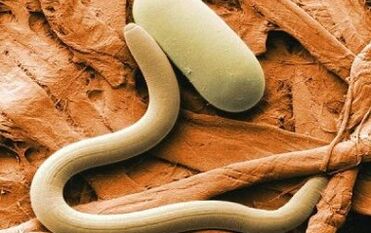
- Contact.Transmission occurs through direct contact from an infected person.The most common is hymenolepidosis caused by Enterobiasis, which is caused by dwarf tapeworms and pinworms.The parasite crawls through the rectum and lays eggs on the skin of a person.Additional distribution occurs through food and household items.Contact The main cause of infection with helminthiasis is non-compliance with the rules of personal hygiene, as well as improper handling and storage of products.
- Geohelminthiases.Typically, no intermediate host is needed;Parasitic worms complete their entire life cycle inside an organism.Eggs and larvae of parasites can live only in the soil, most often in the external environment.Very rare species can grow indoors, only in soil or water.Children who often play with soil and workers on farms and pastures are most susceptible to geohelminthias.Human infection occurs by eating unwashed vegetables and fruits and drinking untreated drinking water.Helminths can enter through dust or skin.
- Biohelminthiasis.For the development of helminths, the presence of an intermediate invertebrate host is necessary.Basically, the transmission of biohelminthias occurs through blood-sucking insects.These types of parasites live in the blood of the final host, enter the insect's body through a bite, then develop and reach another person through the same bite.However, it is also possible to release eggs and larvae into the external environment, as with Geohelminthiases.Each species of helminth requires a specific host species.
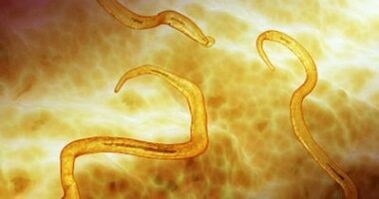
Symptoms and causes of helminthiases
Clinical signs of helminthiasis directly depend on the type of parasites in the human body and their place of residence.Depending on the organ affected, different manifestations of the disease often interfere with an accurate diagnosis.
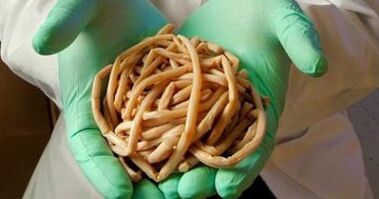
Helminthiasis has passed through acute and chronic stages of development.The acute stage lasts no more than 8 weeks, but the chronic stage can last for years.The acute phase is distinguished by similar symptoms for all types of helminthiasis, because after the appearance of a foreign body in the human body, an immediate reaction of the immune system follows.
Symptoms for the chronic stage are more specific for each specific disease and cannot be generalized.It all depends on the affected organ, for example, when parasites are localized in the intestines, abdominal pain and problems with stool are typical.
Symptoms of helminthiasis:
- Increase in body temperature.
- Excessive sweating and swelling.
- Muscle and joint pain pain.
- Diarrhea or, conversely, frequent constipation.
- Dehydration, frequent vomiting.
- Enlarged liver, spleen, lymph nodes, swelling.
- Rash on human skin.
- An increase in the level of leukocytes.
- Iron deficiency anemia.
- Itching of the skin and anus.
- Nervous system disorders, apathy, irritability, depression.
- If there is bloody discharge in the stool or urine.
- Pancreatitis, jaundice, hepatitis, intestinal obstruction.

Some types of helminthias are characterized by an asymptomatic, latent course of the disease.This is dangerous, because due to severe damage, a person's internal organs can simply be torn, after which the whole body will be infected with false parasites, with such serious consequences as anaphylactic shock or peritonitis.
Special attention should be paid to the manifestations of helminthiasis in children, because they are at the greatest risk.
They are often confused with other diseases and brought to the critical stages of damage to the body.Children's immunity is not yet fully formed and does not show obvious harmful signs.
The most common childhood disease is enterobiasis.In the second place, there are various periods that are most characteristic for children's diseases.It is important to pay attention to the consistency and regularity of the stool, the appearance of various skin rashes, and it is important not to ignore complaints of itching in the anal area.
The main causes of helminthiasis:

- Eating unwashed vegetables, fruits and berries.It is very important to comply with hygiene and sanitary standards.Products purchased with care;It is recommended to use special products for washing fruits and vegetables for children.Hand washing is mandatory before every meal.
- Meat and fish products.To prevent infection and serious consequences, high-quality heat treatment is required, as well as a certificate for the purchased product.Monitor the compliance of prepared semi-finished products with storage conditions.It is not allowed to consume fish products bought on the roadside.
- Earth and sand.This is especially true of children, as they tend to put everything in their mouths.Do not let your child eat the sandbox or sand on the floor in the Summer Cottage during games.Anything that falls on the floor or open space is excluded.
Helminth eggs surround us everywhere, so we must pay special attention to personal hygiene to prevent possible helminthic diseases.
Classification of parasites
Helminths are divided into three classes depending on their form and appearance:
- Roundworms.To date, more than 80 thousand species of helminths of this class have been described.It can seriously damage the human body and cause various helminthic diseases.The development of roundworms goes through 5 stages, of which four are larvae and one is adult.With each switch, environment or intermediate host changes.The most common representatives:
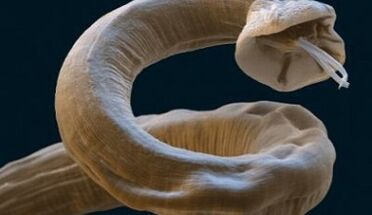
- Roundworm - causes a disease called Ascariasis.This type of parasite is able to live and feed only in the human body.Roundworms are characterized by a cough in which the larvae are pushed into a person's throat and return to the intestines as adults;
- Pinworms cause enterobiasis in the human body and parasitize the intestines.In the body of the host, it is characterized by indigestion, itching near the anus, and in some cases inflammation of the genitals, especially in women.
- TapWorms.There are more than 10 orders of tapeworms living in the human body.This is the most common class of parasites that cause extremely dangerous diseases.They go through two larval stages of development and reach their final host as an adult.They enter the human body from an intermediate host, in most cases through the meat of an infected animal.Therefore, to prevent the disease, it is important to follow the correct preparation and selection of meat products.The most common types of helminths of this class:
- Tapeworm - often causes illness characterized by vomiting, nausea or loss of appetite;
- Bovine tapeworm is a less dangerous disease, but requires very difficult and long-term treatment;
- Echinococcus is a type of worm that causes migraines, dizziness and even an epileptic seizure.
- Flatworms (flukes).What are fluke helminths?An intermediate host is required to develop this class.These parasitic worms are the cause of tremors.The most dangerous species of this class:
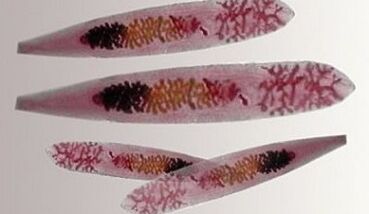
- Fluke Opisthorchiasis - fish meat, the most common type of carp on the human body, affecting the bile ducts of the liver;
- Schistosomes - waterborne, schistosomiasis, a very serious disease with extremely serious consequences;
- Paragonim is a lungless fluke, the cause of paragonim pozagas, infection is possible only by eating crabs, crayfish or pork.
All the listed worms in humans are only a small part of the parasites that exist today.According to some reports, there are more than 1 million species.
Diagnosis and treatment of helminthiasis
Science does not stand still, and many methods have been developed and are actively used to identify helminthic diseases.Modern methods make it possible to accurately determine the types of parasites in humans and the degree of tissue damage in their places.
The main methods for diagnosing helminthiases:
- Microelminticoscopic.It is used to detect eggs and larvae of worms.These include Cato, Kalankaryan and Fulleborn methods.Separately, each of these methods does not allow to accurately identify all types of parasites.But in general, they give good results, especially with regard to the intensity of the spread of parasites living in the body.
- Macrohelminoscopic.Most effective for identifying pinworms and roundworms.Using a Petri dish and a magnifying glass, they help detect parasites in the stool.
- Biopsy.If there is a possibility of helminth parasitism in human muscle tissue, a sample is taken and sent for research.This method allows to make the most accurate diagnosis.
- Immunological.It is carried out by examining the patient's blood to detect antibodies to certain types of helminths living in the human body.
- Analysis of bile or duodenal contents.It is used in cases of damage to the liver, gall bladder and duodenum.
- Instrumental.These include ultrasound, X-ray and computer studies.It is used to determine the degree of damage caused by worms in the human body.Also check other internal organs.
Medicinal methods are used to treat certain diseases.However, it has been established that complex therapy using several drugs is more effective than monotherapy based on one anthelmintic.
Helminth infection is most often treated by prescribing a single dose of a tablet with an active ingredient such as levamisole.The dosage is selected according to the age of the patient.It helps to weaken the parasites.
Then, after 3 days, a drug containing mebendazole or albendazole is taken.This integrated approach significantly speeds up and increases the effectiveness of treatment.
Often, a person does not even know about the worms in his body.In this regard, it is recommended to carry out preventive courses of anthelmintic drugs.This is especially true for preschoolers and pet owners.
In humans, parasites can cause serious damage to internal organs.Timely diagnosis and treatment will help stop the development of these diseases and prevent serious consequences.






































